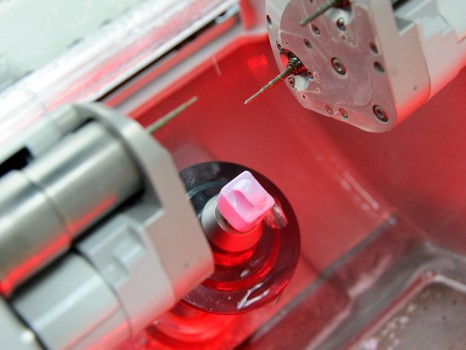Science
Nanotechnology Raises Possibility to Produce Strongest Commercial Pure Aluminum Alloy

- Read more
- 322 reads
NASA’s SOFIA Finds Missing Link Between Supernovae and Planet Formation

SOFIA data reveal warm dust (white) surviving inside a supernova remnant. The SNR Sgr A East cloud is traced in X-rays (blue). Radio emission (red) shows expanding shock waves colliding with surrounding interstellar clouds (green).
- Read more
- 317 reads
New Tech = Faster, Better Dental Work

The Computer Aided Design and Computer Aided Machining fabricator designs a molar for tooth restoration on Joint Base Andrews Dec. 1, 2014.
- Read more
- 352 reads
Clean energy future: New cheap and efficient electrode for splitting water

A scanning electron microscope image shows the porous structure of the nickel foam used to make UNSW Australia's inexpensive and efficient oxygen-producing electrode. The foam has holes in it about 200 micrometers across (Scale bar is 200 micrometers)
- Read more
- 295 reads
Data structures influence speed of quantum search in unexpected ways: Highly connected structures don't always support fastest quantum computing

Quantum search slows unexpectedly on the highly connected data structure represented by this graph. Mathematical description: a 5-simplex with each vertex replaced with a complete graph of 5 vertices.
- Read more
- 305 reads
Nano piano's lullaby could mean storage breakthrough

Arrays of gold, pillar-supported bowtie nanoantennas can be used to record distinct musical notes, in this case, "Twinkle, Twinkle, Little Star."
- Read more
- 321 reads
UK skies set to dim in decade’s deepest solar eclipse

The partial phase of the total eclipse of 2006, rotated to match the appearance of the March 2015 eclipse from the south of England.
- Read more
- 395 reads
New technology may double radio frequency data capacity: Columbia engineers invent nanoscale IC that enables simultaneous transmission and reception at the same frequency in a wireless radio

CoSMIC (Columbia high-Speed and Mm-wave IC) Lab full-duplex transceiver IC that can be implemented in nanoscale CMOS to enable simultaneous transmission and reception at the same frequency in a wireless radio.
- Read more
- 324 reads
NASA Spacecraft in Earth’s Orbit, Preparing to Study Magnetic Reconnection

The United Launch Alliance Atlas V rocket with NASA’s Magnetospheric Multiscale (MMS) spacecraft onboard launches from the Cape Canaveral Air Force Station Space Launch Complex 41, Thursday, March 12, 2015, Florida.
- Read more
- 345 reads
Silver implant nanotech killing infections: NC State Industrial & Systems Engineering Research Team Arms Implants With Battery-Activated Nanotechnology

- Read more
- 349 reads
Human Rights
Fostering a More Humane World: The 28th Eurasian Economic Summi

Conscience, Hope, and Action: Keys to Global Peace and Sustainability

Ringing FOWPAL’s Peace Bell for the World:Nobel Peace Prize Laureates’ Visions and Actions

Protecting the World’s Cultural Diversity for a Sustainable Future

Puppet Show I International Friendship Day 2020

